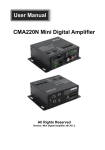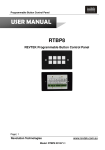Download Photovoltaic Module Installation Manual (IEC)
Transcript
Phono Solar Technology Co., Ltd. PHONO SOLAR TECHNOLOGY CO., LTD. Add: No. 1 Xinghuo Rd., Nanjing Hi-tech Zone, Nanjing, China Tel: +86 25 5863 8000 Fax: +86 25 5863 8009 E-mail: [email protected] Website: www.phonosolar.com Photovoltaic Module Installation Manual (IEC) Version: IEC 2013V1 Copyright © PHONO SOLAR, 2012 CONTENTS 1. IMPORTANT SAFETY GUIDE 2. PRODUCT IDENTIFICATION 3. MECHANICAL INSTALLATION 4. ELECTRICAL INSTALLATION 5. MAINTENANCE 6. DISCLAIMER OF LIABILITY Stability / Reliability / Creativity 1 IMPORTANT SAFETY GUIDE Module (IEC) RatedPower Tolerance RatedPowerVoltage Open iC rcuit Tolerance RatedPowerVoltage RatedPower National Power This manual contains information regarding product identification and the safe installation Module (IEC) RatedPower Tolerance RatedPowerVoltage Open iC rcuit Tolerance RatedPowerVoltage RatedPower National Power and maintenance of photovoltaic modules (hereafter referred to as “module”) supplied by PHONO SOLAR TECHNOLOGY CO., LTD. (hereafter referred to as “PHONO SOLAR”). The term “module” can be interpreted as a single module or multiple modules depending on DO NOT use mirrors or magnifiers to concentrate sunlight onto the module. DO NOT paint the module or attach anything on to the back of the module. DO NOT attempt to disassemble the modules, and do not remove any attached nameplates or components from the module. the context. Installers must already be familiar with the mechanical and electrical requirements for a photovoltaic system. Installers must also read this manual carefully prior to installation. We recommend that you keep this manual in a safe place for future reference and in case of future sale or disposal of the module. 1.1 General Safety The installation of a photovoltaic system requires specialized skills and knowledge and must only be carried out by licensed/qualified persons. Module (IEC) RatedPower Tolerance RatedPowerVoltage Open iC rcuit Tolerance RatedPowerVoltage RatedPower National Power Installers should assume all risks of injury and do everything to avoid potential damages DO NOT lift or move the module by holding the junction box or cable. DO NOT place anything on the module or press on the module surface. Toleranc e R t dP DO NOT drop the module or allow objects to fall on the module. and risks that might occur during installation, including but not limited to, the risks of electric shock. PHONO SOLAR modules do not need special cables for connection. All of the modules have permanent junction boxes, cables and connectors. Do not use mirrors or magnifiers to concentrate sunlight onto the modules. Module (IEC) Rated t Power To Tolerance RatedPowerVoltage Open iC rcuit Tolerance RatedPowerVoltage RatedPower National Power The modules generate DC electrical energy from sunlight. They are designed for outdoor use and can be mounted onto frames on rooftops or in the ground etc. Do not paint the module or attach anything on to the back of the module. Do not attempt to disassemble the modules, and do not remove any attached DO NOT expose the back of the module to direct sunlight. Do NOT install or handle module in wet or strong windy conditions. Do NOT wear metal ornaments while handling the module or during the installation. nameplates or components from the modules. 1.2 Handling safety When handling the module insulated gloves must be worn. Inappropriate transportation and installation may break the module. Do not lift or move the module by holding the junction box or cable. Do not place anything on the module or press on the module surface. Do not drop the module or allow objects to fall on the module. Do not expose the back of the module to direct sunlight. DO NOT drill holes in the frame. DO NOT use module near equipment or in places where flammable gases may be generated or collected. Insulated gloves must be worn while handling the module and during the installation. Do not wear metal ornaments while handling the module. Do not install or handle modules in wet or strong windy conditions. 01 Stability / Reliability / Creativity 1.4 Fire Safety 1.3 Installation safety Local, regional and state laws and regulations must be adhered to while installing a photovoltaic system. For example, any necessary licenses must be obtained prior to the Consult your local authority for guidelines and requirements for building or structural fire safety. installation commencing. Regulations around vehicles and ships must also be observed during the installation. Roof constructions and installations may affect the fire safety of a building; an improper installation may create a hazard in the event of a fire. Observe all safety rules for the other system components, including the cables, Use components such as ground fault circuit breakers and fuses as required by the local authorities. connectors, charging controllers, inverter and storage battery etc. Do not use the modules near a location where flammable gases are either generated or collected. Do not place the modules near a location where flammable gases are either generated or collected. The modules have been rated Fire Class C, and are suitable for mounting onto a Class A roof. Insulated gloves must be worn during the installation. Do not wear metal ornaments during the installation. Do not drill holes in the frame. Under normal conditions, a module is likely to produce more current and/or voltage than reported under Standard Test Conditions (STC). Accordingly, the values of ISC and VOC marked on the module nameplate should be multiplied by a factor when determining the component voltage ratings, conductor current ratings, fuse sizes, and the size of controllers connected to the photovoltaic system. The exact factor value should be suggested by a licensed/qualified person. The connecting ends with electricity may cause fire, spark or lethal shocks even when the modules are not connected. Electricity can be generated when the modules are exposed to sunlight, even if they are not connected. It is dangerous to touch 30V DC or higher, so never open the electrical connectors or unplug the electrical connectors while the circuit is under load, and do not touch the end with electricity during installations, when the modules are exposed to sunlight. Children should be kept away from the photovoltaic system. In order to prevent current and voltage generation during installation an opaque board can be used to cover the modules. Only use licensed/qualified insulated tools. The frame of the modules must be grounded according to local, regional and state safety and electrical standards. A recommended connector or equivalent must be used for the grounding cable. The grounding cable must be appropriately fastened to the module 2 PRODUCT IDENTIFICATION On the back of each module there are 2 labels that provide the following information: Nameplate: Describes the product type, rated power, rated current, rated voltage, open circuit voltage, short circuit current, all as measured under STC; weight, dimensions etc.; the maximum system voltage of 1000V DC. Warning: The value of Voc times the number of modules in series should not be bigger than the maximum system voltage marked in the nameplate. Barcode: This is used to identify each module. Each module has a unique and traceable serial number in the form of barcode. The barcode of each PHONO SOLAR module has 15 letter/digits. Warning: Do not remove the nameplate or barcode. The PHONO SOLAR product warranty will be void if either the module nameplate or barcode is removed. 3 MECHANICAL INSTALLATION (Note: All instructions hereafter are for reference only. A licensed/qualified person or installer must be responsible for the design, installation, mechanical load calculation and security of the photovoltaic system.) 3.1 Select suitable locations for installation Select a suitable location for installing the modules. PHONO SOLAR recommends that to achieve the best performance the modules frame. Only Balance of System (BOS) in conformity to local, regional, state safety electricity should face south in northern latitudes and north in southern latitudes. The exact tilt standards and photovoltaic system such as connectors, cables and frames can be used, angle and orientation of mounted modules should be recommended by a licensed/ avoiding affect on the module performance and/or damage it. qualified installer. 02 03 Stability / Reliability / Creativity The modules should be completely free of shade at all times. Clamp fitting: Using suitable module clamps on the LONG side of the module frame Do not place the modules near a location where flammable gases are either to mount the modules is “portrait orientation” mode, while on the SHORT side of the generated or collected. module frame is “landscape orientation” mode. 3.2 The module clamps should not come into contact with the front glass and must not Select suitable mounting rails Please observe the safety regulations and installation instructions included with the mounting rail. If necessary please contact the supplier directly for further information. deform the module frame. Avoid any shadowing effects from the module clamps. The module frame can not be modified under any circumstances. Regardless of the The modules must be safely set onto the mounting rail. The whole rail supporting the orientation chosen, at least 4 clamps must be used on each module. For portrait photovoltaic system must be strong enough to resist potential mechanical pressures orientation, 2 clamps should be attached to the long sides of the module and for caused either by wind or snow, in accordance with local, regional and state safety (and landscape orientation 2 clamps should be attached to the short sides of the module. other associated) standards. Depending on the local wind and snow loads, additional clamps may be required. The Make sure that the mounting rail will not deform or affect the modules when it applied torque should be about 8Nm. Please find detailed mounting information in the below illustration: expands as a result of thermal expansion. The mounting rail must be made of durable, anti-corrosive and UV-resistant materials. 3.3 Select suitable mounting methods Module Frame Clamp PHONO SOLAR modules can be mounted using two methods: Screw Fitting: Use corrosion-proof screws in the existing installing holes in the module frame. Each module has 8 mounting holes for securing the module on the mounting rail. The module frame must be attached to a mounting rail using M8 Mounting Rail corrosion-proof screws together with spring washers and flat washers in symmetrical M8 Screw locations on the module. The applied torque should be approximately 8Nm. Please find detailed mounting information in the below illustration: Module installed using Clamp Fitting method Select the appropriate installation method depending on the load (see below for more Mounting Rail detailed information). Module Frame M8 Bolt F Type Module Frame Mounting Rail M8 Screw Split Washer Module installed using Screw Fitting method 04 M8 Nut Flat Washer 1580mm × 808mm × 35mm DIAMOND Series ONYX Series U Type DIAMOND Series 1640mm × 992mm × 40mm ONYX Series T Type DIAMOND Series 1956mm x 992mm x 40mm ONYX Series 05 Stability / Reliability / Creativity Phono Solar U Type module Phono Solar F Type module 5400 Pa Load 3800 Pa Load Mounting system Insertion system Clamping system Attachment to the long frame 5/9 Length±50mm 5/9 Length±50mm Length 5/9 Length±50mm Length Length 5/9 Length±50mm Use four clamps Use four clamps Clamping Range (100mm) Clamping Range Long Frame Centre±150mm Clamping Range:from Module Edge to 1/4 Width±50mm Clamping Range Long Frame Centre±150mm Use four clamps on short frame Use four clamps on short frame Insertion system Clamping Range:from Module Edge to 1/4 Width±50mm Width Clamping Range from Module Edge to 1/4 Width±50mm Insertion system Use insertion system on short frame Use insertion system on short frame Clamping Range Long Frame Centre±150mm Useframe four clamps Use four clamps on the short and on the short frame and clamps at the center of each long frame two clamps at the center oftwo each long frame Insertion system Insertion system Clamping Range (100mm) Insertion system A Use four clamps Width Clamping Range from Module Edge to 1/4 Width±50mm Insertion System Insertion System A A Clampingfrom Position A(distance module edge to clamping range) edge to clamping range) A(distance from module Insertion system Clamping Range (100mm) Insertion system Use insertion system on a Use insertion system on a short and two Use frame an insertion short frame and two clamps at the system on acenter long of clamps at the center of each frame long frame each long frame 07 Insertion system 06 Use an insertion system on a long frame Clamping Range (300mm) Insertion system Use insertion system on a short Use insertion system on a short and two Use frame an insertion system frame and two clamps the center on aatlong frame of clamps at the center of each long frame each long frame Use insertion system on short frame A A Insertion system Insertion system Clamping Range:from Clamping Position Module Edge to 1/4 Length±50mm Insertion system Insertion system Clamping Range (100mm) A A Clamping Range Long Frame Centre±150mm Insertion system Insertion system Insertion system Use eight Use four mounting holesmounting holes Use eight mounting holes Clamping Range (100mm) Width Width Use four Use four clamps on the short frame andclamps two on the short frame and two clampsat clampsat the center of each long framethe center of each long frame 5400 Pa Load Clamping Range (300mm) Clamping Range:from Module Edge to 1/4 Length±50mm Clamping system Attachment to the short frame 103mm Width Length Clamping system Attachment to the long frame 103mm 103mm 103mm 5/9 Length±50mm 103mm Width Clamping system Attachment to the short frame Clamping system * Attachment to the short frame Clamping Range Long Frame Centre±150mm Clamping Range Long Frame Centre±150mm Insertion system Insertion system Clamping Range:from Module Edge to 1/4 Width±50mm Clamping Range:from Module Edge to 1/4 Width±50mm Clamping Range (100mm) Use four mounting holes Use four clamps Use six clamps Insertion system Use insertion system on short frame (100mm) Clamping Range Long Frame Centre±150mm Clamping Range Long Frame Centre±150mm Insertion system Insertion system Clamping Range Usefour six clamps Use Insertion system 5400 Pa Load 3800 Pa Load A Clamping Range Clamping Range (300mm) (100mm) Use Usefour fourclamps clamps Insertion system Insertion system Clamping Range (300mm) Clamping Position 3800 Pa Load 2400 Pa Load Use eight mounting holes 103mm 103mm Length 5/9 Length±50mm 5/9 Length±50mm Clamping Range:from Clamping Position Module Edge to 1/4 Length±50mm Use Use four four clamps Use four clamps Clamping system * Attachment to the short frame Use eight Use four mounting holes mounting holes 103mm Clamping Range:from Module Edge to 1/4 Length±50mm Length Length 5/9 Length±50mm Clamping system * Attachment to the long frame Length Clamping system * Attachment to the long frame Use four mounting holes Insertion system 2400 Pa Load 5400 Pa Load Mounting system 3800 Pa Load 2400 Pa Load Mounting system Mounting system 2400 Pa Load Use an insertion system on a long frame Stability / Reliability / Creativity Warning: Do not attempt to drill holes in the module frame or in the glass surface of Phono Solar T Type module the module. Any such modifications will void the PHONO SOLAR product warranty. 3.4 When installing a module on a pole ensure that the pole and mounting rail can withstand anticipated local winds. The pole must be installed on a hard base. 3.5 Ensure that the installation height is such that the lowest modules will not be covered by accumulated snow or shaded by the surroundings. 3.6 Ensure that there is adequate ventilation under the modules, conforming to local, regional and state standards and regulations. 3.7 A minimum distance of 10cm, between the roof plane and the frame of the module is generally recommended. 3.8 Observe the linear thermal expansion of the module frames. A minimum distance of 1cm between two modules is generally recommended. 4 ELECTRICAL INSTALLATION (Note: All instructions hereafter are for reference only. A licensed/qualified person or installer must be responsible for the design, installation, mechanical load calculation and security of the photovoltaic system.) 4.1 Any hardware used must be compatible with the mounting material to avoid galvanic corrosion. 4.2 Only use connectors that are designed for photovoltaic systems and that match PHONO SOLAR modules. 4.3 When working with the connectors only use tools as recommended by the connector manufacturer. 4.4 PHONO SOLAR recommends that the same type of modules are connected together in order to avoid any system power loss. 4.5 The maximum number of series connected modules depends on system design, the type of inverter used and environmental conditions. 4.6 Select insulated cables that are able to resist to ultraviolet radiation and extreme weather conditions. 4.7 The rated voltage of the cable chosen must be appropriate to the overall maximum voltage of the system. 08 09 4.8 The module frame must be grounded according to local, regional and state safety and electrical standards. Ensure that a recommended connector or equivalent is used for the grounding cable. The grounding cable must be properly fastened to the module frame. 5 MAINTENANCE In order to ensure optimum module performance, PHONO SOLAR recommends the following: 5.1 If necessary, the glass front of the module can be cleaned with water and a soft sponge or cloth. A mild, non-abrasive detergent can be used to remove more stubborn stains. 5.2 Check the electrical and mechanical connections periodically and make sure they are clean, safe, complete and secure. 5.3 In the event of a problem, consult with a licensed/qualified person. 6 DISCLAIMER OF LIABILITY Since it is impossible for PHONO SOLAR to control installation, operation, application and maintenance of the photovoltaic system according to this instruction, PHONO SOLAR does not accept responsibility and expressly disclaims liability for any loss, damage, or expense arising out of or in any way connected with such installation, operation, use or maintenance. PHONO SOLAR will not take any responsibilities for any possible violation of patent rights and third party rights that are related to application of the solar energy system. No permission of patents is given through implication. The information of this instruction is from knowledge and experiences of PHONO SOLAR, and so it is reliable. However, the instructions and suggestions of this instruction do not make an external or internal of guarantee. PHONO SOLAR reserves the right to revise this instruction, products and all the information about products without prior notification to customers. 10



















